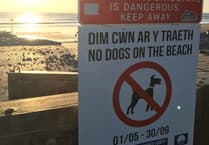Restored peatland in the Cambrian mountains acted as a firebreak, slowing the spread of wildfires, Natural Resources Wales has said.
NRW says their initial assessment of the site has highlighted the benefits of peatland restoration.
Assessing the land following fires earlier this month, NRW found that areas of restored and rewetted peatland at Llyn Gorast, near Ystrad Meurig, were notably more resilient to the fires.
The devastating wildfire that raged for four days across Cwm Rheidol in Ceredigion - scarring the land across an area equivalent to 4,000 football pitches - has sparked urgent calls for action from climate groups, firefighters, and sustainability experts.
Unlike the surrounding singed peat and earth, green pools with sphagnum moss regrowth were observed to have acted as natural firebreaks, limiting the fire’s spread across the landscape.
Environmentalists at the Welsh Government sponsored environmental body say this further demonstrates the value of restoration efforts under the National Peatland Action Programme (NPAP), funded by the Welsh Government and managed by Natural Resources Wales (NRW).
In 2023, restoration work was completed at part of the Llyn Gorast site, which involved constructing dams and contour bunds to raise water levels and reduce erosion.
These actions are crucial in restoring the integrity of heavily eroded peatland sites.
Healthy, rewetted peatlands, such as those at Llyn Gorast, support the growth of wet sphagnum moss, which absorbs up to 20 times its weight in water.
This moisture retention helps prevent the spread of wildfires. In contrast, damaged peatlands can become colonised by Molinia grass, which is highly flammable when dry, increasing the risk of fire.
Mannon Lewis, NRW’s Strategic Projects lead for NPAP explained: “We sent one of our peatland specialists to assess the fire impact on the rewetted Llyn Gorast site and the news was positive.
“The wet pools seem to have been a barrier, preventing the fire from spreading. Pictures also show how an adjacent site, in line for future restoration, was singed black, whilst the restored site was still a functioning peatland. Fleeing wildlife could also have found shelter from the heat in these pools as the fire raged nearby.”
Peatlands cover only four per cent of Wales yet store 30 per cent of our land carbon.
Unfortunately, 90 per cent of Welsh peatland is damaged at present, hence the urgent need for safeguarding and restoration. Reduction in summer rainfall, expected because of climate change, will make damaged peatlands even more prone to fire. This means rewetting peatland, such as at Llyn Gorast, is an important action to help peatland landscapes adapt to the effects of climate change.
Initially a five-year programme, NPAP completed its targets, of restoring 3,000 hectares of peatland, 12 months early. The successful Programme will now be expanded and upscaled to help safeguard our peatlands, accelerate the rate of peatland restoration, and help support Wales’ Net Zero targets. Data on peatland and its restoration, including the site at Llyn Gorast (central), can be found on the Wales Peatland Data Map.





Comments
This article has no comments yet. Be the first to leave a comment.